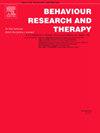相同但不同:威胁预期的改变和恐惧的减少与暴露理由的读数只有微弱的关联,并且对焦虑症的治疗结果有不同的贡献。
IF 4.5
2区 心理学
Q1 PSYCHOLOGY, CLINICAL
引用次数: 0
摘要
个体对暴露疗法的反应各不相同,因此需要更深入地了解其潜在机制。本研究考察了暴露过程中的两个关键过程,作为不同临床原理的读数:(1)会话内恐惧减少(以暴露练习中从恐惧高峰到恐惧结束的下降来衡量)和(2)威胁预期过程(通过预期违反、预期变化和学习率来评估)。研究人员分析了516名焦虑症患者的数据,这些患者在一项临床试验中完成了至少10次暴露练习。结果显示,在暴露练习中,期望测量和恐惧减少只有微弱的相关性。虽然在时间过程中没有发现显著差异,但两种读数都独立地预测了治疗成功。具体来说,更高的学习率和更大的相对恐惧减少与更好的结果相关。这些发现强调了监测恐惧减少和预期相关读数作为两种不同暴露原理的指标的临床相关性-恐惧减少原理和威胁预期原理。虽然目前尚不清楚它们是否反映了单独的变化机制或共同机制的不同方面,但解决这两个基本原理可能有助于优化和个性化暴露治疗。本文章由计算机程序翻译,如有差异,请以英文原文为准。
Same same but different: Threat expectancy change and fear reduction as readouts of exposure rationales are only weakly associated and contribute differentially to treatment outcome in anxiety disorders
Responses to exposure therapy vary across individuals, emphasizing the need for a deeper understanding of its underlying mechanisms. This study examined two key processes during exposure that serve as readouts of different clinical rationales: (1) within-session fear reduction (measured as the decline from peak to end fear within an exposure exercise) and (2) threat expectancy processes (assessed via expectancy violation, expectancy change, and learning rate). Data from 516 patients with anxiety disorders who completed at least 10 exposure exercises in a clinical trial were analyzed. Results showed that expectancy measures and fear reduction were only weakly correlated within exposure exercises. While no significant differences were found in their time courses, both readouts independently predicted treatment success. Specifically, a higher learning rate and greater relative fear reduction were associated with better outcomes. These findings highlight the clinical relevance of monitoring fear reduction and expectancy-related readouts as indicators of two distinct exposure rationales — the fear reduction rationale and the threat expectancy rationale. Although it remains unclear whether they reflect separate mechanisms of change or different aspects of a shared mechanism, addressing both rationales may help optimize and personalize exposure therapy.
求助全文
通过发布文献求助,成功后即可免费获取论文全文。
去求助
来源期刊

Behaviour Research and Therapy
PSYCHOLOGY, CLINICAL-
CiteScore
7.50
自引率
7.30%
发文量
148
期刊介绍:
The major focus of Behaviour Research and Therapy is an experimental psychopathology approach to understanding emotional and behavioral disorders and their prevention and treatment, using cognitive, behavioral, and psychophysiological (including neural) methods and models. This includes laboratory-based experimental studies with healthy, at risk and subclinical individuals that inform clinical application as well as studies with clinically severe samples. The following types of submissions are encouraged: theoretical reviews of mechanisms that contribute to psychopathology and that offer new treatment targets; tests of novel, mechanistically focused psychological interventions, especially ones that include theory-driven or experimentally-derived predictors, moderators and mediators; and innovations in dissemination and implementation of evidence-based practices into clinical practice in psychology and associated fields, especially those that target underlying mechanisms or focus on novel approaches to treatment delivery. In addition to traditional psychological disorders, the scope of the journal includes behavioural medicine (e.g., chronic pain). The journal will not consider manuscripts dealing primarily with measurement, psychometric analyses, and personality assessment.
 求助内容:
求助内容: 应助结果提醒方式:
应助结果提醒方式:


